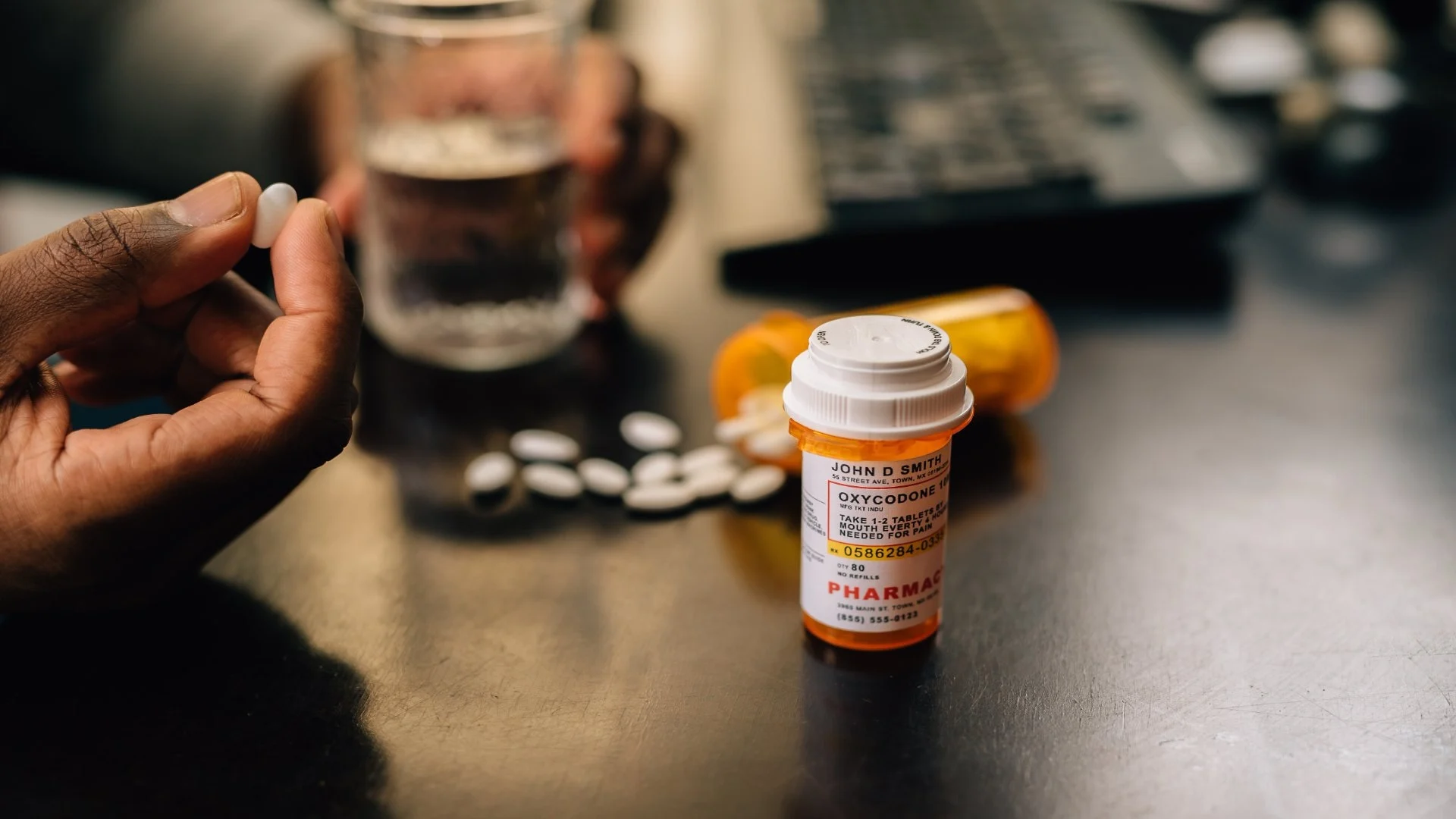Opioid Addiction
Opioids List

Explore the opioids list, including common natural, semi-synthetic, and synthetic opioids, and learn how they impact addiction and the recovery process.
What is the difference between opiates and opioids?
Opiates are naturally derived from the opium poppy plant, such as morphine and codeine. Opioids include both natural and synthetic substances that act on opioid receptors in the brain, providing pain relief but also carrying a risk of misuse and addiction.
Which opioids are considered the most potent?
Fentanyl and its analogs, like carfentanil, are among the most potent opioids. They are significantly stronger than morphine, which makes them highly effective for severe pain but also dramatically increases the risk of overdose, even in small amounts.
Can prescription opioids lead to addiction?
Yes, prescription opioids can lead to addiction, even when taken as prescribed. They affect the brain's reward system, leading to tolerance and dependence. Over time, individuals may require higher doses to achieve the same effect, increasing the risk of addiction.
What are the signs of opioid overdose?
Signs of an opioid overdose include slowed or stopped breathing, pinpoint pupils, unconsciousness, and unresponsiveness. If you suspect someone is overdosing, immediate medical attention is critical. Naloxone, an opioid reversal drug, can save lives if administered quickly.
How is opioid addiction treated?
Opioid addiction treatment often involves medication-assisted treatment (MAT) with medications like methadone or buprenorphine, combined with counseling, behavioral therapies, and support groups. This comprehensive approach helps individuals manage withdrawal symptoms and address the underlying psychological aspects of addiction.
Understanding the different types of opioids is an essential step if you or someone you care about is struggling with addiction. This opioids list outlines common opioids—natural, semi-synthetic, and synthetic—that are often prescribed for pain but can lead to dependency and serious health risks. Opioid misuse affects millions of individuals and families, frequently leading to emotional, physical, and mental health challenges.
By learning more about these substances and their effects, you can take informed steps toward healing, support, and recovery. Whether you're seeking help for yourself or a loved one, you're not alone in this journey.
What Are Opioids?

Opioids are a class of drugs commonly prescribed to manage moderate to severe pain. They work by binding to opioid receptors in the brain and spinal cord, effectively blocking pain signals and producing feelings of relief and, in some cases, euphoria.
Classification of Opioids
Opioids are grouped into three main categories:
Natural Opioids (Opiates): Derived directly from the opium poppy plant. Examples include morphine and codeine.
Semi-Synthetic Opioids: Chemically modified natural opiates, such as oxycodone, hydrocodone, and buprenorphine.
Synthetic Opioids: Fully man-made drugs, including fentanyl, methadone, and tramadol.
Mechanism of Action
Opioids relieve pain by attaching to opioid receptors in the brain, spinal cord, and other parts of the body. This reduces the perception of pain and increases dopamine release, which can lead to a sense of well-being or euphoria.
Opiates Vs. Opioids
While opiates refer specifically to natural substances derived from opium, opioids is a broader term that includes natural, semi-synthetic, and synthetic drugs that act on opioid receptors.
Common Types of Opioids
Opioids come in various forms, classified based on how they are derived or manufactured. Each type carries different levels of potency, medical use, and risk for addiction.
Natural Opioids (Opiates)
These are directly derived from the opium poppy plant.
Morphine: Widely used for severe pain, especially after surgery or in cancer care.
Codeine: Often used in prescription cough medications and mild pain relief.
Opium: Rarely used medically today but historically significant in pain management.
Semi-Synthetic Opioids
These are partially man-made, derived by chemically altering natural opiates.
Oxycodone (e.g., OxyContin, Percocet): Commonly prescribed for moderate to severe pain.
Hydrocodone (e.g., Vicodin, Norco): Frequently used in dental and injury-related pain.
Hydromorphone (e.g., Dilaudid): Potent and used in hospital settings.
Oxymorphone (e.g., Opana): Stronger than morphine, used for chronic pain.
Buprenorphine (e.g., Suboxone, Subutex): Also used in opioid addiction treatment.
Heroin: An illegal opioid with no approved medical use and a high risk of addiction and overdose.
Synthetic Opioids

Entirely manufactured in laboratories, these are often extremely potent.
Fentanyl: Up to 100 times stronger than morphine; linked to many overdose deaths.
Methadone: Used in both pain relief and addiction treatment.
Tramadol: A less potent option for moderate pain.
Meperidine (e.g., Demerol): Used short-term for pain management.
Tapentadol: Treats both pain and nerve-related discomfort.
Carfentanil: Not intended for human use—extremely potent and dangerous.
Medical Uses of Opioids
Opioids are potent medications with several medical applications, primarily for pain management and other therapeutic uses.
Pain Management: Acute and Chronic Pain
Opioids are most commonly prescribed for acute pain following surgery or injury, as well as for chronic pain conditions, such as cancer or severe arthritis. When used correctly, they can significantly improve a patient’s quality of life by providing effective pain relief.
Treatment of Cough and Diarrhea
Some opioids, like codeine, are used in prescription cough syrups to treat severe coughing. Additionally, opioids can be effective in managing diarrhea in cases where other treatments are insufficient.
Use in Anesthesia
Opioids are an essential part of anesthesia, used to manage pain during and after surgery. In these controlled settings, opioids help ensure patient comfort and facilitate recovery by alleviating pain post-operation.

We’re Here To Help You Find Your Way
Would you like more information about mental health or drug addiction? Reach out today.
Risks and Side Effects of Opioid Use
While opioids can be highly effective for pain management, they come with various risks and side effects that should be carefully considered.
Common Side Effects
Opioids often cause drowsiness, which can impair daily functioning and increase the risk of accidents. Constipation is another common side effect due to the way opioids affect the digestive system. Additionally, many individuals experience nausea or vomiting when using opioids, especially during the initial stages of treatment or when the dosage is increased.
Serious Risks
Opioids carry serious risks, particularly when misused or taken for extended periods. Respiratory depression is a life-threatening condition where breathing becomes dangerously slow or shallow, and it is a leading cause of opioid-related deaths.
Overdose is another critical risk, especially with potent opioids like fentanyl. An overdose can lead to unconsciousness, respiratory failure, and death. Furthermore, prolonged opioid use can lead to dependence, where the body becomes reliant on the drug to function normally.
Potential for Misuse and Opioid Use Disorder
Opioids have a high potential for misuse due to their ability to produce euphoria. This can lead to the development of opioid use disorder (OUD), characterized by compulsive use, loss of control, and negative consequences despite harm. Misuse can escalate quickly, resulting in physical and psychological addiction, requiring professional treatment to overcome.
Opioid Addiction and Recovery

Opioid addiction is a serious condition that can take a toll on an individual's physical health, mental well-being, and overall quality of life. Recognizing the signs of opioid addiction and seeking help early is crucial in managing the disorder and beginning the recovery process.
Signs and Symptoms of Opioid Addiction
Opioid addiction, or opioid use disorder (OUD), is characterized by a range of behavioral, physical, and psychological symptoms. Common signs of addiction include:
Increased Tolerance: Over time, a person may need higher doses of opioids to achieve the same effect, which can quickly escalate the risk of overdose.
Cravings and Compulsive Use: Individuals may find themselves thinking about opioids constantly, feeling a compulsive need to use them, and going to great lengths to obtain them.
Loss of Control: Despite attempts to reduce or quit opioid use, individuals may find themselves unable to stop.
Neglecting Responsibilities: Important aspects of life, such as work, relationships, or personal hygiene, are ignored as the addiction takes priority.
Physical Symptoms: These can include drowsiness, slurred speech, constricted pupils, or physical withdrawal symptoms like sweating, nausea, and shaking when opioids are not available.
Treatment Options
Fortunately, opioid addiction is treatable, and there are several options available for recovery. Effective treatment often involves a combination of therapies and support systems tailored to the individual’s needs. Below are the primary treatment options:
Medication-Assisted Treatment (MAT)
MAT is a cornerstone of opioid addiction recovery, involving the use of medications to help manage withdrawal symptoms, reduce cravings, and support long-term recovery. Common drugs used in MAT include:
Methadone: A long-acting opioid agonist that helps reduce withdrawal symptoms and cravings without producing the high associated with opioids.
Buprenorphine: A partial opioid agonist that helps control cravings and withdrawal symptoms while reducing the risk of misuse.
Naltrexone: An opioid antagonist that blocks opioid receptors, preventing opioids from having their usual effects, and can help prevent relapse.
Therapy
Psychological therapies are vital in treating opioid addiction. The two most common forms of treatment are:
Cognitive Behavioral Therapy (CBT): CBT helps individuals identify and change harmful thought patterns and behaviors related to drug use. It also teaches coping strategies for dealing with stress, triggers, and cravings.
Contingency Management (CM): This therapy involves providing positive reinforcement for drug-free behavior, encouraging individuals to stay sober through rewards and incentives.
Therapy helps individuals address the root causes of their addiction, manage emotions, and learn healthier ways to cope with life's challenges.

We’ll Lead You to New Heights
Do you have more questions about mental health or drug addiction? Reach out.
Struggling with Opioid Addiction? We Can Help
Opioid addiction can take a heavy toll on both physical and mental health, but recovery is possible with the proper support and treatment. At The Edge Treatment Center, we understand the complexities of opioid use disorder and offer personalized treatment plans to help you or your loved one on the path to recovery.
Whether through medication-assisted treatment, therapy, or support groups, we are here to provide the professional help needed to regain control and build a healthier, drug-free life. Don't wait to get the support you deserve—reach out today.

We’re Here To Help You Find Your Way
If you or a loved one is struggling with addiction, there is hope. Our team can guide you on your journey to recovery. Call us today.
Written by
The Edge Treatment Center
Reviewed by
 Jeremy Arzt
Jeremy ArztChief Clinical Officer
Opioid Addiction
July 26, 2025
